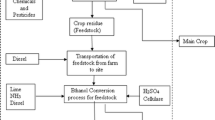Abstract
This study assesses the environmental performance of biomass feedstocks, rice husk, wheat stalk, cotton stalk, sorghum stalk, and sugarcane bagasse, for ethanol production in India. The analysis calculates emergy indicators and demonstrates the dilemma in selection of biomass feedstocks for meeting the ethanol blending target decided by the biofuel policy of the Government of India. It considers spatial variability, and computes the production potential of each lignocellulosic feedstock considered in the study. Achieving high return on energy invested, high renewability, and large production rates simultaneously seems difficult for the considered feedstocks. Among these cellulosic feedstocks, rice husk shows highest renewability and ethanol production potential. Although sorghum stalk has a high return on investment, it has lowest renewability among the feedstocks considered in the study. Rice husk and cotton stalk should be targeted first to fulfil the blending demand of gasoline as they show highest renewability and quality corrected emergy return on investment, along with a high production potential. Emergy analysis of cellulosic biofuels can provide a holistic platform for decision makers for designing the biofuel policy and selection of feedstock in the Indian context.





Similar content being viewed by others
References
Agoramoorthy G, Hsu MJ, Chaudhary S, Shieh PC (2009) Can biofuel crops alleviate tribal poverty in India’s drylands? Appl Energy 86:S118–S124
Baral A, Bakshi BR, Smith RL (2012) Assessing resource intensity and renewability of cellulosic ethanol technologies using eco-LCA. Environ Sci Technol 46(4):2436–2444
Bastianoni S, Marchettini N (1996) Ethanol production from biomass: analysis of process efficiency and sustainability. Biomass Bioenergy 11(5):411–418
Brown MT, Buranakarn V (2003) Emergy indices and ratios for sustainable material cycles and recycle options. Resour Conserv Recycl 38(1):1–22
Brown MT, Ulgiati S (1997) Emergy-based indices and ratios to evaluate sustainability: monitoring economies and technology toward environmentally sound innovation. Ecol Eng 9:51–69
Cao K, Feng X (2007) Distribution of emergy indices and its application. Energy Fuels 21:1717–1723
Chavez-Rodriguez MF, Nebra NA (2010) Assessing GHG emissions, ecological footprint, and water linkage for different fuels. Environ Sci Technol 44:9252–9257
Coppola F, Bastianoni S, Ostergard H (2009) Sustainability of bioethanol production from wheat with recycled residues as evaluated by Emergy assessment. Biomass Bioenergy 33:1626–1642
Dong X, Ulgiati S, Yan M, Zhang X, Gao W (2008) Energy and eMergy evaluation of bioethanol production from wheat in Henan Province, China. Energy Policy 36:3882–3892
Felix ER (2006) Integrated energy, environmental and financial analysis of biofuel production from switchgrass, hybrid poplar, soybean and casterbean. M.S. University of Maryland, College Park
Felix E, Tilley DR (2009) Integrated energy, environmental and financial analysis of ethanol production from cellulosic switchgrass. Energy 34:410–436
Goh CS, Lee KT (2010) Palm-based biofuel refinery (PBR) to substitute petroleum refinery: an energy and emergy assessment. Renew Sustain Energy Rev 14(9):2986–2995
Hau JL, Bakshi BR (2004) Promise and problems of emergy analysis. Ecol Model 178:215–225
Jia C, Zhang J, Zhai Y, Li T (2010) Emergy analysis of cassava -based fuel ethanol in china in 2010. In: 2nd Conference on environmental science and information application technology, pp 486–488
Liao W, Heijungs R, Huppes G (2011) Is bioethanol a sustainable energy source? An energy-, exergy-, and emergy-based thermodynamic system analysis. Renew Energy 36(12):3479–3487
Liu J, Lin B, Sagisaka M (2012) Sustainability assessment of bioethanol and petroleum fuel production in Japan based on emergy analysis. Energy Policy 44:23–33
Lu H, Lin B, Campbell DE, Sagisaka M, Ren H (2012) Biofuel vs. biodiversity? Integrated emergy and economic cost-benefit evaluation of rice-ethanol production in Japan. Energy 46(1):442–450
Mandade P, Bakshi BR, Yadav GD (2015) Ethanol from Indian agro-industrial lignocellulosic biomass—a life cycle evaluation of energy, greenhouse gases, land and water. Int J Life Cycle Assess 20(12):1649–1658
Martin JF, Diemont SAW, Powell E, Stanton M, Levytacher S (2006) Emergy evaluation of the performance and sustainability of three agricultural systems with different scales and management. Agric Ecosyst Environ 115:128–140
National Policy on Biofuels (2009) Govt. of India, Ministry of New and Renewable Energy, pp 1–18
Odum, HT (1996) Environmental accounting: emergy and environmental decision making. Wiley, New York, 370 pp
Ometto AR, Ramos PAR, Lombardi G (2007) The benefits of a Brazilian agro- industrial symbiosis system and the strategies to make it happen. J Clean Prod 15:1253–1258
Pereira CLF, Ortega E (2010) Sustainability assessment of large-scale ethanol production from sugarcane. J Clean Prod 18(1):77–82
Pizzigallo ACI, Granai C, Borsa S (2008) The joint use of LCA and emergy evaluation for the analysis of two Italian wine farms. J Environ Manag 86:397–406
Rugani B, Panasiuk D, Benetto E (2012) An input-output based framework to evaluate human labor in life cycle assessment. Int J Life Cycle Assess 17:795–812
Sukumaran RK, Surender VJ, Sindhu R, Binod P, Janu KU, Sajna KV, Rajasree KP, Pandey A (2010) Lignocellulosic ethanol in India: prospects, challenges and feedstock availability. Bioresour Technol 101(13):4826–4833
Ukidwe NU, Bakshi BR (2005) Flow of natural versus economic capital in industrial supply networks and its implications to sustainability. Environ Sci Technol 39(24):9759–9769
Ulgiati S, Brown MT (1998) Monitoring patterns of sustainability in natural and man-made ecosystems. Ecol Model 108:23–36
Yang H, Chen L, Yan Z, Wang H (2010) Emergy analysis of cassava-based fuel ethanol in China. Biomass Bioenergy 1:581–589
Zhou SY, Zhang B, Cai ZF (2010) Emergy analysis of a farm biogas project in China: a biophysical perspective of agricultural ecological engineering. Commun Nonlinear Sci Numer Simulat 15(5):1408–1418
Acknowledgments
Partial funding for this work was provided by the University Grants Commission, Government of India.
Author information
Authors and Affiliations
Corresponding author
Electronic supplementary material
Below is the link to the electronic supplementary material.
Rights and permissions
About this article
Cite this article
Mandade, P., Bakshi, B.R. & Yadav, G.D. Ethanol from Indian agro-industrial lignocellulosic biomass: an emergy evaluation. Clean Techn Environ Policy 18, 2625–2634 (2016). https://doi.org/10.1007/s10098-016-1179-y
Received:
Accepted:
Published:
Issue Date:
DOI: https://doi.org/10.1007/s10098-016-1179-y




